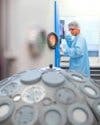FISBA produces small optical windows using technical and optical glass
FISBA OPTIK AG, St. Gallen, Switzerland, has improved the process for precise manufacturing of small optical windows in high quantities. This allows for using technical and optical glass instead of plastic. Material, design, polishing, and coating are highly customizable.
Transparent covers are increasingly in demand for protecting high-class optical systems of mobile phone cameras, mini-projectors or micro-scanners. Optical windows are also required in medical and laser technology, telecommunications and for opto-electronic components and sensors. Due to cost reasons, plastic has thereby often been used instead of glass.
FISBA is now able to drastically reduce the cost per unit for optical windows made of glass. Thereby, a large variety of technical and optical glass types can be used. The possible forms are manifold: round, elliptical, triangular and even polyangular, with individually designable lateral surfaces, edges and even notches. The precision of the form lies at +/- 0.01 mm with +/- 0.02 mm for the thickness.
The small windows that FISBA produces in lots starting at several 100,000 pieces can have a thickness between 0.5 mm and 5.0 mm at a circle diameter of 0.5 mm to 5.0 mm. Top, bottom, and lateral surface are polished customer-specifically (polish quality up to P3) and coated dielectrically or metallically. This allows for achieving various cosmetic and functional effects.
